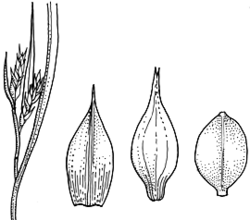Carex jackiana Boott APNI* 
Description: Rhizome long; shoots ± densely tufted, often forming a dense stand 1 m diam. Culms very short, hidden amongst leaves, more or less trigonous, more or less smooth, 1–6[–50] cm long, c. 0.7 mm diam.
Leaves much exceeding culms, to 30 cm long; blade 2.5–5 mm wide; sheath yellow-brown; ligule obtuse to retuse.
Inflorescence erect, narrow, 1–3 cm long, with 3–7 spikes solitary at nodes; lowest involucral bracts exceeding inflorescence. Spikes sessile, contiguous, erect at maturity, 0.8–1.5 cm long; uppermost spike male or rarely gynaecandrous; lower spikes female. Glumes acute to acuminate, often long-mucronate (mucro to 2 mm long), whitish to pale red-brown with green midrib; female glumes 2.5–5 mm long. Perigynia (utricles) ovoid, thickened at base, many-nerved, 4–6.5 mm long, 1.3–2 mm diam., glabrous, greenish to pale yellow-brown; beak 1–2 mm long, with apex split to notched. Anthers 1.5–2 mm long excluding appendage to 0.1 mm long. Style 3-fid.
Nut obovoid to ellipsoid, trigonous in cross section, pale yellow-brown.
Flowering: summer.
Distribution and occurrence: Mt Kosciusko area. Grows in wet places in alpine and subalpine areas.
NSW subdivisions: ST
Other Australian states: Vic.
Culms and inflorescences are shorter than in the (typical) trop. material.
Text by K. L. Wilson (1993); edited KL Wilson (Aug 2016)
Taxon concept: Flora of NSW 4 (1993)
APNI* Provides a link to the Australian Plant Name Index (hosted by the Australian National Botanic Gardens) for comprehensive bibliographic data
***The AVH map option provides a detailed interactive Australia wide distribution map drawn from collections held by all major Australian herbaria participating in the Australian Virtual Herbarium project.
|


